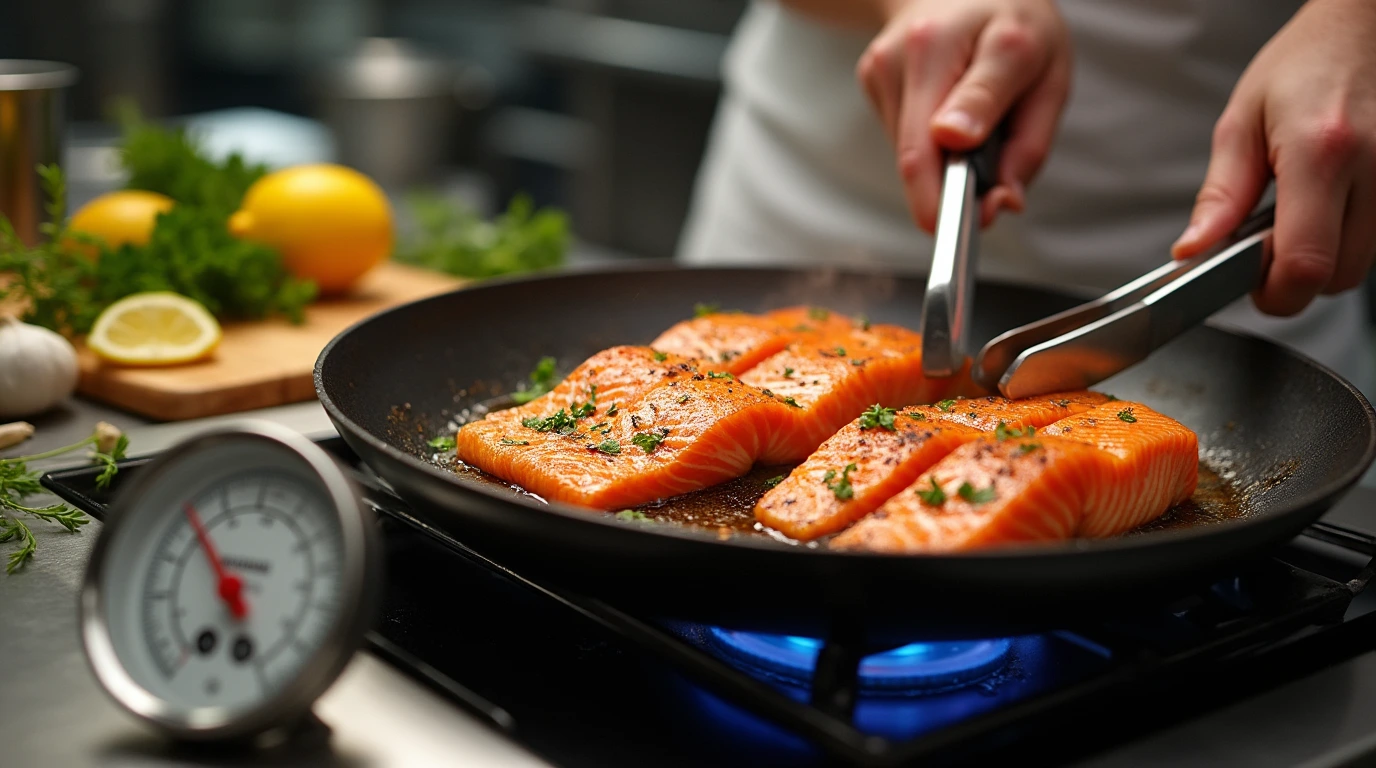Have you ever wondered how to achieve perfectly smoked salmon every time? The secret lies in mastering the internal temperature. Smoked salmon is a culinary treasure—moist, flavorful, and versatile enough to shine at breakfast, lunch, or dinner. Whether you’re a seasoned smoker or trying this technique for the first time, understanding how to hit the ideal internal temperature can make all the difference. In this recipe, we’ll guide you through every step to ensure your salmon turns out tender, flaky, and packed with rich, smoky goodness. Let’s unlock the secrets to the best-smoked salmon you’ve ever made!
Table of Contents
Key Benefits of Internal Temp Smoked Salmon
Smoking salmon to the perfect internal temperature is more than just a cooking technique—it’s the key to unlocking its full potential. Here’s why this step is so important and how it can elevate your smoked salmon game:
- Ensures Perfect Texture: Achieving the right internal temperature (120–135°F for most smoked salmon) guarantees tender, flaky fish that isn’t overcooked or dry.
- Enhances Flavor: Proper smoking lets the salmon absorb just the right amount of smoky goodness while retaining its natural richness.
- Prioritizes Food Safety: Monitoring the temperature ensures the salmon is safely cooked, especially if you’re working with raw, sushi-grade fish.
- Customizable Results: Whether you prefer a soft, buttery texture or a firmer bite, controlling the temperature allows you to tailor the final product to your taste.
- Impresses Guests: Perfectly smoked salmon isn’t just a meal; it’s an experience. Serve it at your next gathering, and you’ll have everyone asking for your secret.
Ingredients for Internal Temp Smoked Salmon
Gathering the right ingredients is the first step toward perfectly smoked salmon. Each component plays a vital role in enhancing flavor and ensuring the fish is moist and delicious. Here’s what you’ll need:
For the Salmon:
- 1 lb fresh salmon fillet: Skin-on is recommended to keep the fish intact during smoking.
- Salt: Use kosher salt for an even seasoning.
- Sugar: Brown sugar or granulated sugar helps balance the saltiness and adds a subtle sweetness.
For the Brine (Optional but Recommended):
- 4 cups water
- 1/4 cup kosher salt
- 1/4 cup brown sugar
- 1 tsp black peppercorns
- 2 cloves garlic (crushed)
- 1 bay leaf
For Smoking:
- Wood chips: Alder, cherry, or applewood are great choices for a mild, smoky flavor.
- Olive oil: A light brush before smoking prevents the fish from drying out.
- Seasonings: Optional additions like smoked paprika, dill, or lemon zest can elevate the flavor.
Why These Ingredients Matter:
- Fresh Salmon: The star of the recipe! Opt for high-quality, fresh salmon for the best results.
- Brine: Adds flavor, locks in moisture, and prevents the fish from drying out during smoking.
- Wood Chips: The type of wood you use will influence the overall flavor profile of your salmon.
- Seasonings: These allow you to customize the dish to your personal taste preferences.

Instructions for Perfectly Smoked Salmon
Smoking salmon to perfection is easier than you might think! Follow these step-by-step instructions to achieve tender, flavorful results every time.
1. Prepare the Salmon
- Rinse the salmon fillet under cold water and pat it dry with a paper towel.
- If using a brine, combine water, salt, sugar, and other brine ingredients in a large bowl. Submerge the salmon and refrigerate for 4–6 hours. This step helps enhance the flavor and keep the fish moist.
- Remove the salmon from the brine, rinse gently, and pat dry.
2. Preheat the Smoker
- Set your smoker to a temperature of 180°F to 200°F. This low-and-slow method ensures even cooking.
- Add your choice of wood chips (like alder, cherry, or applewood) for a delicate smoky flavor.
3. Season the Salmon
- Lightly brush the salmon with olive oil to prevent sticking and drying out.
- Sprinkle your preferred seasonings, such as smoked paprika, dill, or lemon zest, for added flavor.
4. Smoke the Salmon
- Place the salmon on the smoker grate, skin-side down.
- Insert a meat thermometer into the thickest part of the fillet to monitor the internal temperature.
- Smoke the salmon until it reaches an internal temperature of 120°F to 135°F. This typically takes 1.5 to 2 hours, depending on the thickness of the fillet.
5. Rest and Serve
- Once the salmon reaches the desired internal temperature, remove it from the smoker.
- Let it rest for 5–10 minutes to allow the juices to redistribute.
- Serve warm or chilled, depending on your preference.
Tips for Success
- Don’t Skip the Thermometer: Monitoring the internal temperature is the key to perfectly cooked salmon.
- Avoid Overcrowding: Leave space around the salmon in the smoker for even heat circulation.
- Experiment with Wood Chips: Try different woods to discover your favorite flavor profile.
By following these instructions, you’ll achieve smoked salmon that’s moist, flavorful, and cooked to perfection!
Pro Tips and Variations for Smoked Salmon
Achieving smoked salmon perfection takes more than just following a recipe—it’s about those little details that make all the difference. Here are some pro tips and creative variations to take your smoked salmon to the next level:
Pro Tips for Perfect Results
- Master the Internal Temperature: Always use a meat thermometer to monitor the salmon. Aim for an internal temperature of 120°F to 135°F for tender, flaky fish.
- Choose Quality Salmon: Fresh, high-quality salmon fillets make a noticeable difference in taste and texture. Wild-caught salmon is ideal for its rich flavor.
- Pat Dry After Brining: After brining, thoroughly pat the salmon dry. This step helps the fish form a beautiful pellicle, a thin layer that locks in smoke and flavor.
- Experiment with Woods: For a mild, classic flavor, use alder or cherry wood. For a bolder taste, try hickory or mesquite.
- Avoid Over-smoking: Too much smoke can overpower the salmon’s natural flavor. A subtle, steady smoke is best.
Flavor Variations to Try
- Sweet and Spicy Glaze: Brush the salmon with a mixture of honey, soy sauce, and sriracha during the last 15 minutes of smoking.
- Citrus Herb Delight: Sprinkle fresh dill, parsley, and lemon zest over the fillet before smoking for a bright, fresh twist.
- Maple Bourbon Infusion: Marinate the salmon in maple syrup, a splash of bourbon, and cracked black pepper for a smoky-sweet flavor profile.
- Garlic Butter Infusion: Before smoking, slather the salmon with a mix of melted butter, minced garlic, and a dash of smoked paprika for a rich, savory finish.
Common Pitfalls to Avoid
- Skipping the Resting Time: Allowing the salmon to rest after smoking helps retain its juices and ensures the flavors settle perfectly.
- Overcrowding the Smoker: Leave space between fillets to ensure even smoking and heat distribution.
- Relying on Time Alone: Always prioritize internal temperature over estimated cooking time for consistent results.
By following these tips and exploring different flavor variations, you’ll not only create perfectly smoked salmon but also discover exciting new ways to enjoy this versatile dish!
Serving Suggestions for Smoked Salmon
Smoked salmon is a versatile dish that can transform any meal into a gourmet experience. Whether you’re hosting a brunch or preparing a quick weeknight dinner, these serving ideas will inspire you to enjoy your perfectly smoked salmon in new and exciting ways.
Classic Pairings
- Bagels and Cream Cheese: Top a toasted bagel with cream cheese, capers, red onion slices, and smoked salmon for a timeless favorite.
- Salmon Salad: Toss smoked salmon into a fresh salad with mixed greens, avocado, cherry tomatoes, and a tangy lemon vinaigrette.
- Charcuterie Boards: Add slices of smoked salmon to a board with crackers, cheese, pickles, and fresh fruit for a crowd-pleasing appetizer.
Creative Meal Ideas
- Smoked Salmon Pasta: Stir flaked smoked salmon into a creamy alfredo sauce and toss with fettuccine for a rich, indulgent dinner.
- Rice Bowls: Layer smoked salmon over a bed of steamed rice with sliced cucumbers, shredded carrots, and a drizzle of soy sauce or spicy mayo.
- Breakfast Scramble: Fold chunks of smoked salmon into scrambled eggs with fresh dill and chives for a protein-packed start to your day.
Light and Refreshing Options
- Cucumber Bites: Top cucumber slices with a dollop of cream cheese and a piece of smoked salmon for a low-carb appetizer.
- Lettuce Wraps: Wrap smoked salmon with avocado, shredded cabbage, and a touch of wasabi mayo in crisp lettuce leaves for a refreshing snack.
- Smoked Salmon Sushi: Use your smoked salmon to create homemade sushi rolls with seaweed, rice, and your favorite fillings.
Pro Tips for Presentations
- Garnish for Elegance: Add a sprinkle of fresh herbs like dill or parsley, a squeeze of lemon juice, or a twist of black pepper to elevate the presentation.
- Serve Warm or Cold: Smoked salmon is delicious at any temperature—warm for hearty meals or chilled for light appetizers.
- Pair with Wine: A glass of crisp white wine, like Sauvignon Blanc, or a sparkling option, complements the smoky richness beautifully.
FAQs About Internal Temp Smoked Salmon
1. What is the ideal internal temperature for smoked salmon?
The ideal internal temperature for smoked salmon is between 120°F and 135°F. This range ensures the fish is tender, flaky, and fully cooked while retaining its natural moisture. For cold-smoked salmon, temperatures are kept much lower (around 80°F), but requires a curing process.
2. How do I measure the internal temperature accurately?
Use a reliable meat thermometer and insert it into the thickest part of the salmon. Ensure the probe doesn’t touch the skin or smoker grates for an accurate reading. For consistent results, monitor the temperature closely as the fish nears completion.
3. Can I smoke frozen salmon?
Yes, but it’s best to thaw the salmon completely before smoking. Smoking frozen salmon can result in uneven cooking, as the exterior may overcook before the interior is fully done.
4. What type of wood chips should I use for smoking salmon?
Mild woods like alder, cherry, or applewood are excellent choices for salmon as they complement the fish’s delicate flavor. For a more robust taste, try hickory or mesquite in moderation.
5. How long does it take to smoke salmon?
Smoking salmon typically takes 1.5 to 2 hours at a smoker temperature of 180°F to 200°F. However, always prioritize the internal temperature over the cooking time to achieve the best results.
What do you think of these recipes?
There are no reviews yet. Be the first one to write one.












